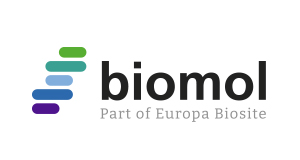Stromal Cell-Derived Factor-1 beta (CXCL12), feline recombinant (rfSDF1b)
Stromal Cell-Derived Factor-1 beta (CXCL12), feline recombinant (rfSDF1b)
Kategorie: Cytokines
Formulation: purified
Storage: -20°C
Weight: 8526 D
Description: Chemoattractant active on T-lymphocytes, monocytes, but not neutrophils. Activates the C-X-C chemokine receptor CXCR4 to induce a rapid and transient rise in the level of intracellular calcium ions and chemotaxis. Acts as a positive regulator of monocyte migration and a negative regulator of monocyte adhesion via the Lyn kinase. Stimulates migration of monocytes through its receptor, CXCR4, and decreases monocyte adherence to surfaces coated with ICAM-1, a ligand for beta-2 integrins. SDF1A/CXCR4 signaling axis inhibits beta-2 integrin LFA-1 mediated adhesion of monocytes to ICAM-1 through Lyn kinase (By similarity). (www.uniprot.org) Recombinant feline Stromal Cell-Derived Factor-1 beta produced in E.coli is a non-glycosylated, polypeptide chain containing 72 amino acids and having a molecular mass of 8526 Dalton. SDF-1 (stromal cell-derived factor-1) is small cytokine belonging to the chemokine family that is officially designated Chemokine (C-X-C motif) ligand 12 (CXCL12). It is produced in two forms, SDF-1alpha/CXCL12a and SDF-1beta/CXCL12b, by alternate splicing of the same gene. Chemokines are characterized by the presence of four conserved cysteines, which form two disulfide bonds. The CXCL12 proteins belong to the group of CXC chemokines, whose initial pair of cysteines are separated by one intervening amino acid. CXCL12 is strongly chemotactic for lymphocytes and has been implicated as an important cell co-ordinator during development. During embryogenesis it directs the migration of hematopoietic cells from foetal liver to bone marrow. Mice which were knocked-out for CXCL12 gene were lethal before the birth or within just 1 hour of life. As another role, CXCL12a alters also the electrophysiology of neurons. CXCL12 was shown to be expressend in many tissues in mice (including brain, thymus, heart, lung, liver, kidney, spleen and bone marrow). The receptor for this chemokine is CXCR4, which was previously called fusin. This CXCL12-CXCR4 interaction used to be considered exclusive (unlike for other chemokines and their receptors), but recently it was suggested that CXCL12 is also bound by CXCR7 receptor. The gene for CXCL12 is located on human chromosome 10. In human and mouse both CXCL12 and CXCR4 show high identity of sequence: 99% and 90%, respectively.
Formulation: purified
Storage: -20°C
Weight: 8526 D
Description: Chemoattractant active on T-lymphocytes, monocytes, but not neutrophils. Activates the C-X-C chemokine receptor CXCR4 to induce a rapid and transient rise in the level of intracellular calcium ions and chemotaxis. Acts as a positive regulator of monocyte migration and a negative regulator of monocyte adhesion via the Lyn kinase. Stimulates migration of monocytes through its receptor, CXCR4, and decreases monocyte adherence to surfaces coated with ICAM-1, a ligand for beta-2 integrins. SDF1A/CXCR4 signaling axis inhibits beta-2 integrin LFA-1 mediated adhesion of monocytes to ICAM-1 through Lyn kinase (By similarity). (www.uniprot.org) Recombinant feline Stromal Cell-Derived Factor-1 beta produced in E.coli is a non-glycosylated, polypeptide chain containing 72 amino acids and having a molecular mass of 8526 Dalton. SDF-1 (stromal cell-derived factor-1) is small cytokine belonging to the chemokine family that is officially designated Chemokine (C-X-C motif) ligand 12 (CXCL12). It is produced in two forms, SDF-1alpha/CXCL12a and SDF-1beta/CXCL12b, by alternate splicing of the same gene. Chemokines are characterized by the presence of four conserved cysteines, which form two disulfide bonds. The CXCL12 proteins belong to the group of CXC chemokines, whose initial pair of cysteines are separated by one intervening amino acid. CXCL12 is strongly chemotactic for lymphocytes and has been implicated as an important cell co-ordinator during development. During embryogenesis it directs the migration of hematopoietic cells from foetal liver to bone marrow. Mice which were knocked-out for CXCL12 gene were lethal before the birth or within just 1 hour of life. As another role, CXCL12a alters also the electrophysiology of neurons. CXCL12 was shown to be expressend in many tissues in mice (including brain, thymus, heart, lung, liver, kidney, spleen and bone marrow). The receptor for this chemokine is CXCR4, which was previously called fusin. This CXCL12-CXCR4 interaction used to be considered exclusive (unlike for other chemokines and their receptors), but recently it was suggested that CXCL12 is also bound by CXCR7 receptor. The gene for CXCL12 is located on human chromosome 10. In human and mouse both CXCL12 and CXCR4 show high identity of sequence: 99% and 90%, respectively.
| SKU | BOL97336.1 |
|---|---|
| Manufacturer | Biomol |
| Manufacturer SKU | 97336.1 |
| Package Unit | 1 mg |
| Quantity Unit | STK |
| Reactivity | Cat (Feline) |
| Host | Escherichia Coli |
| Product information (PDF) | Download |
| MSDS (PDF) |
|

 Deutsch
Deutsch






